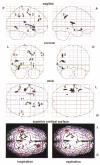Functional MRI localisation of central nervous system regions associated with volitional inspiration in humans
- PMID: 10523407
- PMCID: PMC2269603
- DOI: 10.1111/j.1469-7793.1999.00383.x
Functional MRI localisation of central nervous system regions associated with volitional inspiration in humans
Abstract
1. Functional magnetic resonance imaging (fMRI) provides a means of studying neuronal circuits that control respiratory muscles in humans with better spatial and temporal resolution than in previous positron emission tomography (PET) studies. 2. Whole brain blood oxygenation level-dependent (BOLD) changes determined by fMRI were used to identify areas of neuronal activation associated with volitional inspiration in five healthy men. Four series of scans of each subject were acquired during voluntary breathing (active task) and mechanical ventilation (passive task). Ventilation and end-tidal PCO2 were similar between tasks. Scan data were re-aligned to correct for movement artefacts and cross-referenced breath by breath to respiratory data for selective averaging of inspiratory and expiratory images. 3. Group analysis identified significant increases in the fMRI signal with volitional inspiration in the superior motor cortex, premotor cortex and supplementary motor area at loci similar to those detected in earlier studies that used PET. Additional regions activated by volitional inspiration included inferolateral sensorimotor cortex, prefrontal cortex and striatum (these foci were only revealed by PET under significant inspiratory load). 4. This study represents the first synchronised breath-by-breath analysis of respiratory-related neuronal activity with whole brain imaging in humans. Temporal resolution is sufficient to distinguish individual breaths at a normal breathing frequency.
Figures



References
-
- Bandettini PA, Jesmanowicz A, Wong EC, Hyde JS. Processing strategies for time-course data sets in functional MRI of the human brain. Magnetic Resonance in Medicine. 1993;30:161–173. - PubMed
-
- Binder JR, Rao SM, Hammeke TA, Yetkin FZ, Jesmanowicz A, Bandettini PA, Wong EC, Estkowski LD, Goldstein MD, Haughton VM, Hyde JS. Functional magnetic resonance imaging of the human auditory cortex. Annals of Neurology. 1994;35:662–672. - PubMed
-
- Dale AM, Buckner RL. Selective averaging of rapidly presented individual trials using fMRI. Human Brain Mapping. 1997;5:329–340. - PubMed
Publication types
MeSH terms
Substances
Grants and funding
LinkOut - more resources
Full Text Sources
Other Literature Sources
Medical

